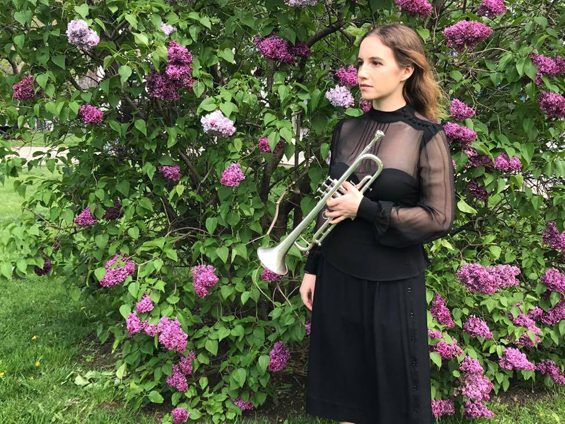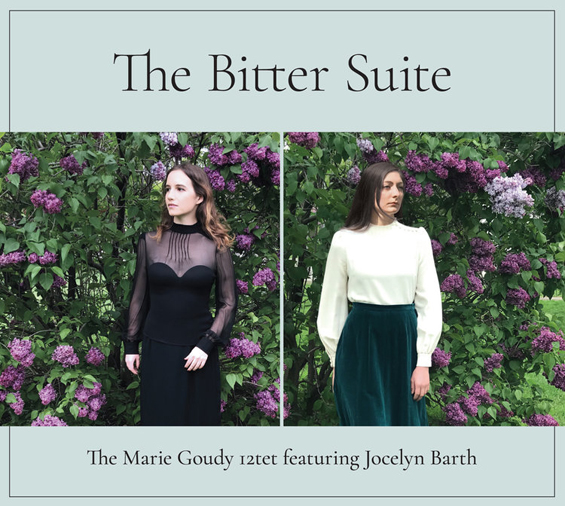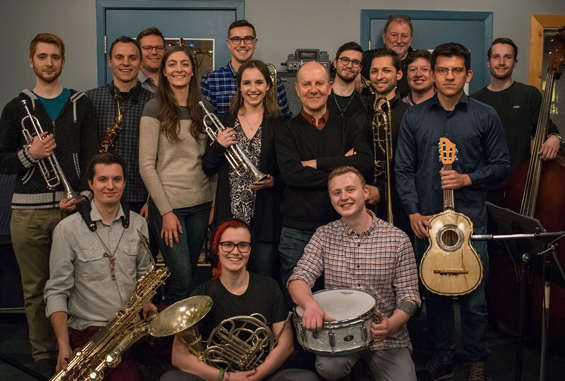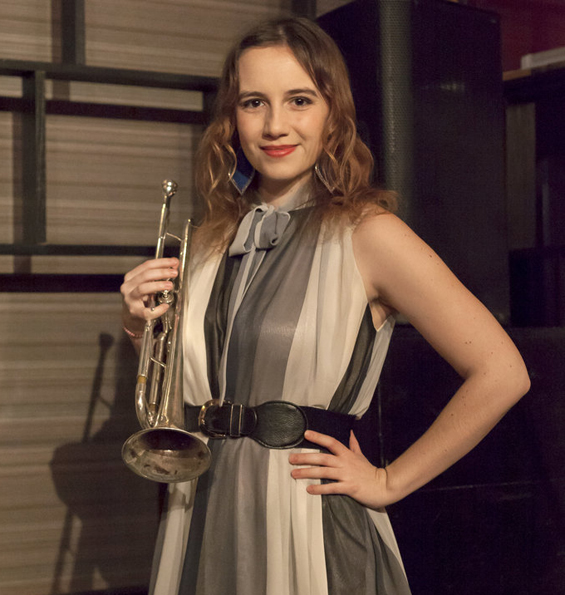

photo:
Bill Beard
FIVE QUESTIONS WITH MARIE GOUDY
The Bitter Suite, the debut album by the Marie Goudy 12tet, is a remarkably assured and accomplished recording by a trumpeter who only a year ago graduated from the University of Toronto's Masters in Jazz Performance program (reviewed here). But don't be fooled: Goudy, a native of Toronto who began her professional career at the age of sixteen, has been honing her craft for many years and brings a considerable degree of experience to the project. Artists with whom she's played include Benny Golson, Cleo Laine, Donny McCaslin, and Maria Schneider, and Goudy's established herself in the Toronto music scene as someone adept at not only jazz but funk, mariachi, folk, and Latin music, too. It's The Bitter Suite, however, that is her current focus, and a better showcase for her talents would be hard to imagine: after composing and arranging all of the music, she guided the twelve musicians (fourteen, including herself and singer Jocelyn Barth) through a multi-part jazz-orchestra work that might reference Maria Schneider, Marty Paich, and Kenny Wheeler as touchstones but ultimately impresses as a portrait of Goudy above all else. Recently, textura had a chance to speak with her about the project, the mariachi connection, and what the future holds.
1. What prompted you to tackle such an ambitious project for your debut rather than something more modest (like a small-group set of originals and standards), and was there ever a moment during the album's creation when you had trepidation about taking on a project of such scope?
I knew that if I was going to undertake a recording project, it would have to be something I'm very passionate about. I do like playing small group jazz but it doesn't thrill me half as much as large ensemble. I feel that if I were to record a small group album it would be another run-of-the-mill trumpet quartet album, but I think that my artistic voice really shines through this 12tet album and I've made something really special. It definitely was difficult, but I had funding from both the Ontario Arts Council and the Toronto Arts Council and that helped a lot! I honestly can't recall a time during the process where the size of the ensemble stressed me out; I think the aspects that stressed me out would have been the same even in a smaller group. Having John MacLeod on board as my producer really helped ease my mind as well; he's such an experienced veteran of this whole process, and he knew what to do every step of the way.

2. From where did the idea of using the four seasons as a foundation for The Bitter Suite originate, as well as the idea of pairing it with the changes in a romantic relationship?
I actually started by writing the last movement of the suite, “Lilacs,” as a standalone piece. I was lying on a deck looking at the lilac bushes and thinking about how fragrant they are when they bloom, and how I've heard that the sense of smell is the one most strongly connected to memory. And I thought about how sad it would be if someone had a bad experience while the air was full of the lilac flower fragrance and that they'd be doomed to relive it each year when the flowers bloom again. A few months later it was January, and I had written the melody to what would become “Winter.” It was one of those snowy days where everything is coated and the world seems almost deaf under the blanket of snow, so that came out in my lyrics. After I finished, I realized that “Winter” could be seen as a prequel of sorts to “Lilacs,” and in realizing that they both relate to seasons I decided to flesh it out and write songs for summer and autumn as well.
3. It's unusual to hear mariachi music emerge in a jazz context. Where did your interest in that particular form come from?
I've been playing full-time in a mariachi band since I was twenty-one, so it definitely encompasses a lot of my life! A lot of the most well-known mariachi songs are kind of hokey, like “The Mexican Hat Dance” or “La Cucaracha,” but there are some really amazing, beautiful, and complicated pieces that aren't well known in Canada or the United States. I wanted to take something with these exquisite grooves like Son Jaliciense and Huapango and merge it with big band jazz to share those styles with my jazz-listening community.

photo:
Danielle Smiley
4. The Bitter Suite impresses on multiple grounds. The writing is very strong and so too are the luscious arrangements. How did you decide on the allocation of the solos that appear in the different parts (for example, were you purposefully connecting specific instruments and players to the seasonal tone of a track), and how easily do composing and arranging come to you?
Thank you! Some of the solos were very obvious; the other trumpeter, Brad Eaton, and I both play together in a mariachi band so the trumpet duel on “Son for Sunshine” was a chance for us to show off our mariachi as well as jazz chops; and I think bright trumpet solos help the picture of an exciting, fresh summer. In “Winter,” the electric guitar solo is reminiscent of howling winter winds, and Chris Platt did a fantastic job of encompassing that vibe. The others I can't put into words as easily; it just felt right to have that specific instrument sound at that time.
I find composing and arranging comes in waves for me: either I'll sit at a piano for hours and not write anything good, or sit down and in twenty minutes I've composed an entire song. But the more I practice writing ‘bad' stuff, the easier it is for the ‘good' stuff to find its way to the surface. It definitely helps to have an idea of what I want the song to be, or in some cases what I want it not to be. With arranging I find writing dense, horn-heavy sections to be an easy pleasure but have more trouble arranging rhythm section parts. It's also something I'm working on!

photo: Bill Beard
5. While I'm guessing that the creation and now promotion of this album have consumed the greater share of your time and energy, I imagine you're looking ahead, too. What's next for Marie Goudy?
Well, I'm almost halfway through my next big compositional project! I've taken an ancient Greek myth about Artemis and Orion and modified it to be a fantasy story called “The Huntress and the Giant” that I'm telling through lyrics. I've written and arranged four movements so far, and I think at the end it'll be around nine. I also added three new musicians to my band: a lead trumpet player, another alto sax player (I've moved my current lead alto sax player to soprano sax permanently), and a male vocalist. My goal is to record and release it along with a little illustrated book of the lyrics.October 2018![]()